
Virtua Fighter is a fighting game created for the Sega Model 1 arcade platform by AM2, a development group within Sega, headed by Yu Suzuki. An early prototype version was location tested in Japan by August 1993, before the complete game was released worldwide in December 1993. It is the first game in the Virtua Fighter series, and the first arcade fighting game to feature fully 3D polygon graphics. The game has been ported to several platforms including the Sega Saturn, Sega 32X, and Microsoft Windows.
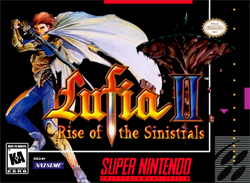
Lufia II: Rise of the Sinistrals, known as Estpolis Denki II in Japan, and as Lufia in Europe and Australia, is a role-playing video game with puzzle elements developed by Neverland and published in Japan in 1995 by Taito, and in North America and Europe in 1996 by Natsume and Nintendo respectively, for the Super Nintendo Entertainment System. It is the second game in the Lufia series.
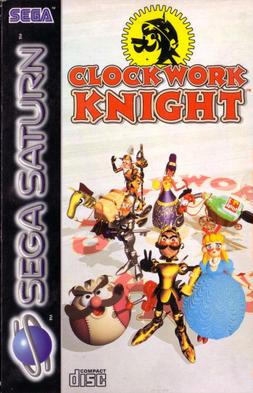
Clockwork Knight is a side-scrolling platform video game developed and published by Sega for the Sega Saturn. It was released in Japan in December 1994, in North America on the 1995 launch, and in Europe on July 8, 1995. Reviews were mixed, with critics praising the advanced graphics but criticizing the low difficulty, short length, and lack of gameplay innovation. It was followed by Clockwork Knight 2.
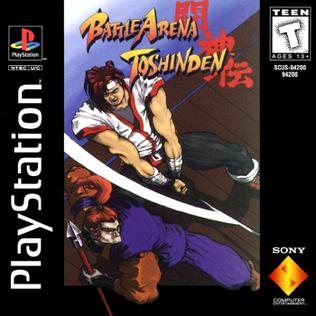
Battle Arena Toshinden, also transliterated Toh Shin Den, is a fighting video game developed by Tamsoft and published by Takara for the PlayStation. Originally released in 1995, it was released internationally by Sony Computer Entertainment, followed by 1996 ports for the Sega Saturn, Game Boy and MS-DOS. It was one of the first fighting games, after Virtua Fighter in 1993 on arcade and console, to boast polygonal characters in a 3D environment, and features a sidestep maneuver which is credited for taking the genre into "true 3D."

Dynamite Headdy is a platform video game developed by Treasure and published by Sega for the Sega Genesis in 1994. The game follows a puppet named Headdy in his efforts to stop an evil puppet king from taking over his world. Headdy can throw his head at enemies to defeat them and use it to pull himself to various areas and move objects. The player can find a wide variety of "heads" which act as power-ups that provide different effects and alter gameplay.

Gunstar Heroes is a run and gun video game developed by Treasure and published by Sega. It was Treasure's debut game, originally released for the Sega Genesis in 1993. The game's premise is centered around a pair of characters, the Gunstars, in their efforts to stop an evil empire from recovering four powerful gems. The characters can fire guns and perform a series of acrobatic maneuvers to fight enemies across each stage. There are four weapons in the game which can be combined with one another to create different shot types.
1991 saw many sequels and prequels in video games, such as Street Fighter II, Final Fantasy IV, Super Castlevania IV, Mega Man 4, Super Ghouls 'n Ghosts, and The Legend of Zelda: A Link to the Past, along with new titles such as Sonic the Hedgehog, Battletoads, Lemmings, Sunset Riders, Duke Nukem, Fatal Fury: King of Fighters, and Streets of Rage. The year's highest-grossing video game worldwide was Capcom's arcade fighting game Street Fighter II. The year's best-selling system was the Game Boy for the second year in a row, while the year's best-selling home video game was Sega's Sonic the Hedgehog, which was also the year's top video game rental in the United States.
1990 saw many sequels and prequels in video games, such as Metal Gear 2: Solid Snake, Dr. Mario, Dragon Quest IV, Final Fantasy III, Phantasy Star II, and Super Mario World, along with new titles such as Fire Emblem: Shadow Dragon and the Blade of Light and Magic Sword. The year's highest-grossing arcade video games were Final Fight in Japan and Teenage Mutant Ninja Turtles in the United States. The year's best‑selling system was the Game Boy, while the year's best-selling home video game was Super Mario Bros. 3 for the Nintendo Entertainment System.

Gunstar Super Heroes is a run and gun video game for the Game Boy Advance developed by Treasure and published by Sega in 2005. It is the sequel to the 1993 Sega Genesis game Gunstar Heroes, with the story taking place after the events of the original game and featuring an expanded combat system over its predecessor.
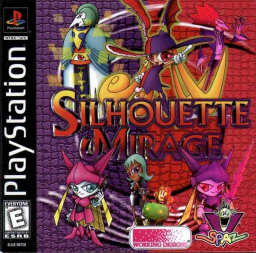
Silhouette Mirage is a 2D action side-scrolling video game developed by Treasure and released in 1997. The game's primary mechanic is the two opposing attributes, "Silhouette" and "Mirage" and the way they are able to cause damage to each other. Shyna features as the female protagonist who is able to switch between these attributes at will by facing either left or right on-screen. Secondary mechanics in the form of various melee moves are used to get enemies onto the correct side of the screen so that when Shyna is facing them, she is able to use the correct, opposing attribute to damage them.

Alien Soldier is a side-scrolling run and gun video game developed by Treasure and published by Sega for the Mega Drive. Retail copies were released in Japan and PAL territories while in North America it was only available exclusively via the Sega Channel cable service. The story follows a powerful being named Epsilon-Eagle, who after being nearly killed becomes determined to avenge his near death and save his planet. The character has a variety of weapons and moves that the player must master to complete the game. Many gameplay ideas are borrowed from Treasure's earlier Mega Drive release, Gunstar Heroes (1993). However, Alien Soldier puts an emphasis on challenging boss fights with short and easy levels serving as downtime in-between.
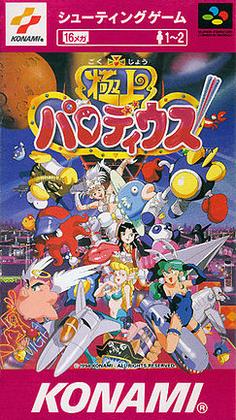
Gokujō Parodius ~Kako no Eikō o Motomete~, translated as Gokujo Parodius – Pursuing the Past Glory and also known as Fantastic Journey, is a 1994 side-scrolling shooter arcade game developed and published by Konami. It is the third entry in their Parodius series, itself a parody spin-off of their Gradius series.

Raiden Project, known outside Japan as The Raiden Project, is a scrolling shooter video game developed and published by Seibu Kaihatsu for the PlayStation. It is a compilation of the arcade games Raiden (1990) and Raiden II (1993). It was released in Japan on January 27, 1995, for North America by Sony Computer Entertainment as an original launch title on September 9, 1995, and in Europe by Ocean Software in November 12, 1995. This was the only console release of Raiden II and unlike previous ports, these versions are based directly on the arcade originals. The Project version of the first Raiden was available as a download from the Japanese PlayStation Network store, which could be played on either a PlayStation 3 or a PlayStation Portable.

This is a listing of notable characters from the video game Chrono Trigger, a role-playing video game released in 1995 by Square Co. for the Super Nintendo Entertainment System video game console. In keeping with the time travel theme of the game's storyline, the characters hail from different eras of a fictional history, ranging from prehistory to a post-apocalyptic future.
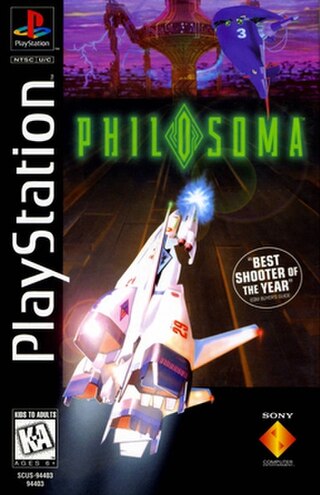
Philosoma is a shooter video game developed by G-Artists and published by Sony Computer Entertainment for the PlayStation. It was released in Japan in July 1995, North America in January 1996 and PAL territories in March 1996. It was re-released on the PlayStation Network in Japan on April 26, 2007. One of the earliest PlayStation games, it was met with mediocre reviews, with most critics assessing its graphics as dull and its gameplay as primitive.

Tekken (鉄拳) is a fighting game developed and published by Namco. It was originally released for arcades in 1994, and ported to the PlayStation a year later. The game was well-received by critics. It is the first entry in the Tekken series, with a sequel, Tekken 2, being released in 1995.

Space Harrier II is the sequel to Space Harrier, developed and published by Sega. First released on October 29, 1988, it was one of the original launch titles released for the Mega Drive in Japan and one of the six Sega Genesis launch titles in the United States the following year. It was also later released on the Wii's Virtual Console in December 2006, and on the Nintendo Switch Online + Expansion Pack in April 2022. Like Altered Beast, another launch title for the Mega Drive, Space Harrier II features digitized human voice recordings during gameplay, and is also an example of some of the Mega Drive's early sound, composed by Tokuhiko Uwabo. A graphically enhanced version included with the Sega Genesis Mini 2 was released October 2022.

Samurai Shodown, known in Japan as Samurai Spirits, is a fighting game developed and published by SNK for the Neo Geo arcade and home platform. Released in 1993, it is the first installment in the Samurai Shodown series. In contrast to other fighting games at the time, which were set in modern times and focused primarily on hand-to-hand combat, Samurai Shodown is set in feudal-era Japan and was SNK's first arcade fighting game to focus primarily on weapon-based combat.

Metal Gear is an action-adventure stealth video game developed and published by Konami for the MSX2. It was released for the system in Japan and parts of Europe in 1987. Considered the game to popularize the stealth game genre, it was the first video game to be fully developed by Hideo Kojima, who would go on to direct most of the games in the Metal Gear series. A reworked port of the game was released for the Famicom a few months later, which later saw release in international markets for the NES over the following two years; this version was developed without Kojima's involvement and features drastically altered level designs, among other changes. An emulated Famicom version came with the special edition of Metal Gear Solid: The Twin Snakes on GameCube. A more faithful port of the MSX2 version was later included in Metal Gear Solid 3: Subsistence for the PlayStation 2, as well as in the HD Edition of the same game released for the PlayStation 3, Xbox 360 and PlayStation Vita, with these newer ports featuring a revised translation and additional gameplay features. The MSX version was also released for Wii Virtual Console and PC.
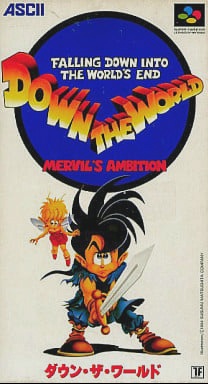
Down the World: Mervil's Ambition is a role-playing video game (RPG) developed and published by ASCII Corporation for the Super Famicom. The plot follows the knight Gao, tasked with accompanying a hero in rescuing an ailing princess and preventing the end of all life.

















